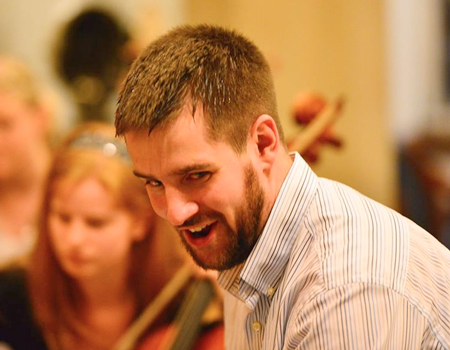by David Kulma

A perfect example was the second “Chamber Music in the Round” program by Earth and Air: String Orchestra in Tucker Hall at St. Paul’s Episcopal Church on Friday evening, February 8. Billed as featuring Alban Berg’s String Quartet of 1910, in fact this 25-minute piece was the only work on the program. Director and cellist David Ellis announced he would take half an hour to give the audience an aural roadmap to this majestically confusing music. Then he played it in full with his excellent ad hoc quartet-mates: violinists Caroline Joyner and Corinne Auger, and violist Anna Gerber.
The performance was wonderful — Ellis and friends clearly put a lot of work into this fiendishly difficult music. When they bowed close to the bridge, it was delightfully creepy, emphasizing the dissonant soundscape as though with an icy highlighter. The dense, constantly changing texture kept emotions high, even in moments of calm. The overall effect in Berg’s two movements was of a continuous storm, and these musicians buffeted the air beautifully. The circular seating plan gave the whole experience an intimacy missing from usual fourth-wall concert setups.
Ellis’s demonstration with musical examples by the quartet was engaging and informative. He gave some background and pointed out the differences between tonality, atonality, and twelve-tone music. The quartet also played important chunks of the score, including the opening 2nd violin curlicue and the virtuosic ending twice in a row.
Ellis’s talk focused on Berg’s joining of emotional scope to intellectual form. Like Mahler, Berg filled his music to the brim with emotion that lacked a clear, direct narrative. And like Bach, he built dense contrapuntal worlds with numerological puzzles that will never exhaust scholars. The main difference, as Ellis pointed out, was that Berg chose unapologetic dissonance as his main tool.
To show this synthesis, Ellis began with the last two chords — the clear 3-note d minor and the final 4-note crunch. Then, in an unexpected sleight-of-hand, he argued that the work’s major moments emphasize the five notes missing from those ending harmonies. Ellis pointed out these important and clearly audible notes as the quartet toured the zeniths of the score.
The talk failed to mention some important structural features of Berg’s work. Still, that tour planted those highlights in my memory, so their return in context was a joy to recognize, especially the C-sharps at the second-movement climax.
Published on ClevelandClassical.com February 18, 2019.
Click here for a printable copy of this article



